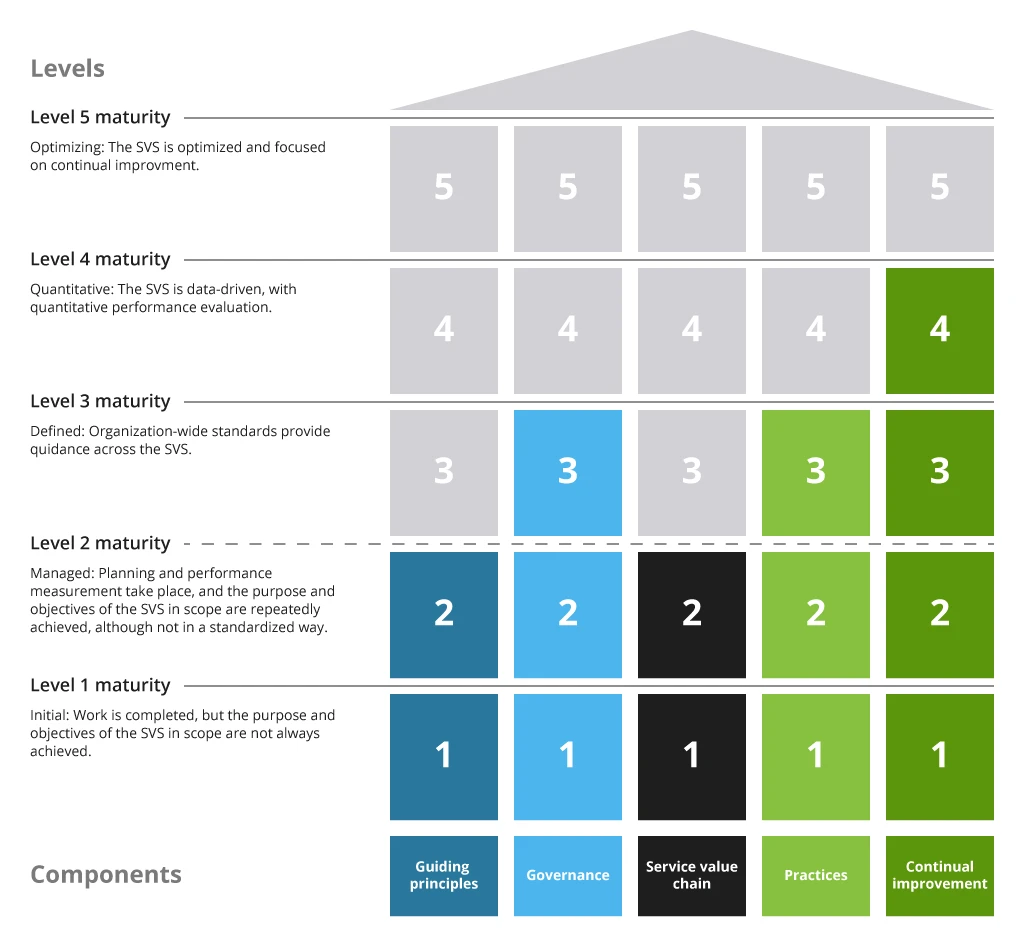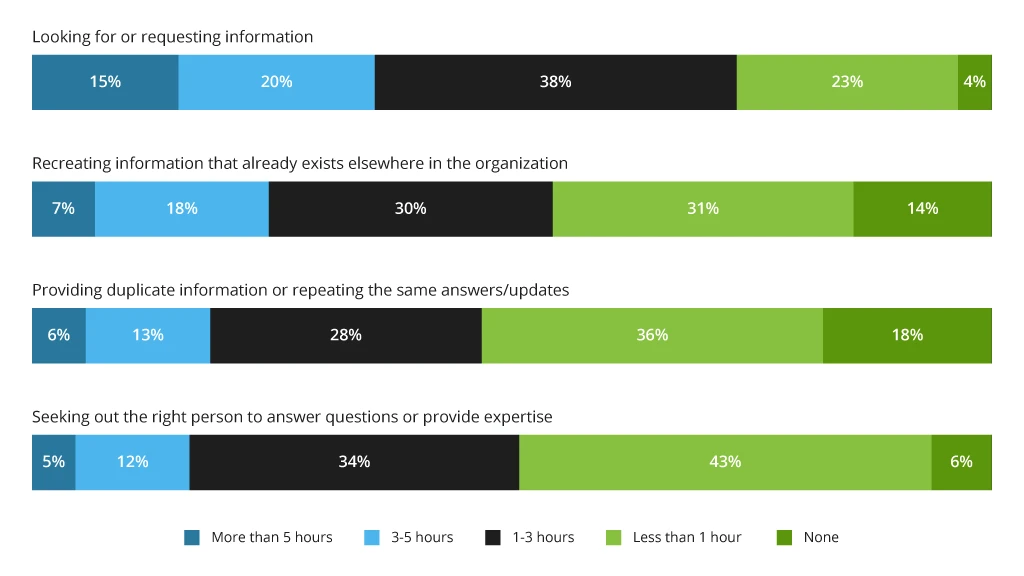Evolving Your IT Service Management: 4 Key Areas for Growth
IT Service Management maturity models offer a valuable tool to assess the quality of service delivery and identify areas for improvement. This proactive approach is especially important considering the impact of IT issues on the overall company’s performance. Research by ITSM tools shows a staggering 84% of respondents across all organization sizes understand the negative impact service issues and failures have on business operations.
By aligning ITSM maturity with business goals, organizations can ensure they're getting the most out of their service management investments, focusing on improvements that directly benefit the bottom line.
IT Service Management Maturity Model
The Information Technology Infrastructure Library (ITIL) is a collection of best practices and frameworks designed to help organizations manage their IT services effectively, regardless of the specific organization or technology involved. This allows organizations to establish a baseline for their IT service management processes and then use ITIL to improve the quality and delivery of those services.
ITIL offers a five-level maturity model to assess your organization's IT service management capabilities. These levels are progressive, meaning each level builds upon the one before it. You need to achieve the previous level's characteristics before effectively assessing the current level:
- Initial: Basic processes exist but are reactive and inconsistent.
- Managed: Defined processes are in place but with limited control.
- Defined: Standardized processes with documented procedures.
- Quantitative: Processes are actively monitored and measured.
- Optimized: Continuous improvement through automation and innovation.
1. Streamline and Standardize Your ITSM Processes
At Level 1, the IT service management strategy is defined by the lack of standardization across processes and management activities.
Level 1 challenges. Operations and services teams have fragmented toolkits and siloed access to data. As a result, their activities are highly uncoordinated and cannot be pinned to specific IT service management metrics as performance monitoring does not exist. Since most processes are undocumented, the ITSM team is putting down emerging fires, rather than working on ensuring continuous, smooth operations and service provisioning.
By implementing a structured approach to infrastructure management, the company can simplify systems, streamline maintenance, and free up valuable time for IT teams to focus on strategic initiatives and directly support business user needs.
How to resolve Level 1 issues:
- Focus on redefining IT service management practices and processes. Each process needs to be aligned with the relevant business context for higher efficiency. Introduce repeatability into all the daily actions and promote the habit of acting according to the set practices.
- Create preliminary Standard Operating Procedures (SOPs). Work with the IT leaders to determine the optimal set of procedures for common tasks and requests. Create the necessary documentation and consider training to build up any lacking IT service management skills.
- Start building a business case for automation. Based on the defined processes and SOPs, start assessing IT service management software vendors that could provide toolkits for automation. JIRA service desk is a basic solution, popular with technical teams. ServiceNow is a more comprehensive, enterprise-grade platform.
Complement your IT service management transformation with legacy system modernization to reduce the volumes of regular and emergency maintenance work ITSM teams need to deal with.
2. Bring Consistency to Your IT Service Delivery
Your company has taken a great first step towards strong ITSM by establishing repeatable processes for many ITIL functions. This consistency in handling standard tasks ensures a predictable user experience. Capturing this knowledge by formally documenting these processes will further strengthen your ITSM foundation and allow for continuous improvement.
According to APQC’s research, a quarter of knowledge workers spend 3+ hours each week processing duplicate information or repeating the same answers/updates. That’s hundreds of hours a year wasted on repetitive work that could have been delegated.
Level 2 issues. The ITSM department has a defined set of goals and objectives. However, individual or team metrics for IT service management are not set or fully monitored. Coordination between people or different teams is low as the communication remains siloed and in-effective. Feedback is occasionally provided by stakeholders but in an ad-hoc manner. ITSM professionals still have a limited understanding of how their activity affects stakeholder outcomes.
How to resolve Level 2 issues:
- Resolve IT isolation. Formalize and document processes to create a clear reference point for everyone. Commit to creating a more diverse range of resources and SOPs every individual can refer to. Set clear communication policies to promote a timely escalation of issues and increase collaboration between individuals. Start involving more business stakeholders to reduce any confusion around priorities, requirements, and overall strategic direction.
- Procedure standardization. Continue your efforts of consolidating redundant processes, adding automation, and increasing the levels of standardization across all repeatable procedures.
- Adopt tiered support/service desk. To improve service level consistency, start breaking down your ITSM center into tiers to “filter” different issues by type, priority, and complexity. Introduce automation (self-service) for Tier 0 issue resolution and map out proper escalation procedures for more complex ones. Ensure that each Tier is adequately staffed, and every specialist has sufficient access, knowledge, and tools for resolving their set of tasks. Consider an external IT infrastructure management service provider if you lack in-house resources.
Case in point. Infopulse provided a self-service portal solution for a leading steel belt manufacturer to establish their own ITSM processes, operations, and support from scratch. The solution integrated Tietoevry Enterprise ITSM System and Active Directory with a chosen ServiceNow ITSM system, Azure, and Office 365 for software license provisioning, and Microsoft Intune for software provisioning. The portal optimized end-user request processing and streamlined the ticket history, resulting in faster issue resolution, real-time visibility, better flexibility, and efficiency. It also enabled the automation of Service Desk operations and software provisioning and streamlined ITSM processes, including Asset Management, Procurement, License Management, and User Management.
3. Introduce a Culture of Excellence in IT Service Management
At the level 3 maturity organizations have already established a strong foundation with documented and readily accessible SOPs and standardized processes. Team roles are well-defined with clearly defined metrics for performance evaluation, leading to consistent and efficient operations. As a result, ITSM teams operate with higher consistency and efficiency.
Level 3 issues. While procedures are well-defined and rarely require ad-hoc adjustments, the overall approach prioritizes reaction over proactive measures. Repetitive tasks lack automation, and there’s no direct mechanism in place to ensure that all individuals follow the set procedures.
How to resolve Level 3 issues:
- Address cultural resistance. Actively solicit feedback to refine procedures and foster knowledge sharing to accelerate the adoption of new ITIL practices. This effort requires a two-pronged approach, tackling resistance at both team member and management levels.
- Consider integrated ITSM solutions. to achieve consistency and improve coordination across IT management and maintenance activities, explore multi-capability vendors, like ServiceNow or Microsoft System Center Service Management (SCSM). These vendors offer integrated IT service management solutions that provide consolidated visibility into different functions, systems, and assets.
4. Implement Strategic Automation
Your company has achieved an impressive Level 4 maturity in ITSM. You've established a strong connection between your IT service management activities and your overall business strategy. All procedures are documented, consistently followed, measured, and monitored for compliance.
While automation is already deployed for most processes, there's an opportunity to further optimize by transitioning from ad-hoc implementation to a more strategic approach.
How to resolve Level 4 issues:
- Introduce a greater extent of automation: graduate from ad-hoc automation by implementing Robotic process automation (RPA) solutions for repetitive ITSM tasks. Explore the world of ML-powered infrastructure monitoring systems that can proactively identify potential issues before they disrupt service, minimizing downtime and enhancing customer satisfaction. In 2022, improving the team's productivity through the use of automation solutions was named a top priority for 57% of organizations.
Case in point. Infopulse developed a proprietary integrated solution for managing cloud environments and services for one of the largest IT services companies in Europe. The solution provided the client with a single platform for managing their cloud resources and automating IT processes. The integration with ServiceNow ITSM allowed for better visibility and control of cloud resources, improved incident and change management, and increased efficiency in IT service delivery.
Level 5: The Pinnacle of IT Service Management
Level 5 signifies a highly optimized and cost-effective IT environment, perfectly aligned with your business goals.
Here's what Level 5 looks like:
- Seamless Automation: Streamlined process automation, task coordination, and monitoring across the entire service lifecycle.
- Agile Response: Your IT team becomes an agile powerhouse, adapting to changing business needs and realigning processes as required.
- Data-Driven Decisions: Every process is meticulously measured against stakeholder requirements.
- Feedback Loop: A robust feedback loop ensures ongoing optimization and adaptation of service delivery.
- Eliminating Waste: Redundant or ineffective procedures are a thing of the past. Automation is strategically implemented wherever possible.
- Proactive Service: Your IT team anticipates needs, delivering reliable services and proactively addressing requests.
While Level 5 represents the pinnacle of IT service management maturity, it's crucial to maintain this excellence. Continuous monitoring, performance assessment, and adaptation are still essential. Regularly evaluate the effectiveness of your processes and refine your approach to ensure your IT service delivery remains consistently exceptional.
In Conclusion
Optimized ITSM isn't just about efficiency; it fosters a collaborative and knowledge-sharing environment where IT seamlessly integrates with the broader business.
The ITIL 4 framework empowers you to achieve this by providing a structured approach to IT service delivery and management, ultimately leading to:
- Reduced IT costs
- Elevated service levels
- Improved employee productivity and efficiency
- Enhanced customer satisfaction
Understanding your ITIL maturity level is the first step toward achieving these benefits. This self-assessment helps you identify areas for improvement and define clear targets.
If you're considering IT service management transformation, explore the available solutions and choose the approach that best aligns with your company's unique needs.
Infopulse is a Premier ServiceNow implementation vendor, offering a range of consulting, integration, and implementation services. We offer a comprehensive range of consulting, integration, and implementation services to help you set up full-scale ITSM and ITOM solutions.





![Robocall Mitigation Solutions [thumbnail]](/uploads/media/thumbnail-280x222-caller-line-identification-spoofing-and-robocall-4-mitigation-solutions.webp)
![How to Choose MFA [thumbnail]](/uploads/media/thumbnail-280x222-how-to-choose-the-right-mfa-approach-for-your company.webp)
![Cloud-Native Maturity Model Assessment [thumbnail]](/uploads/media/thumbnail-280x222-what-Is-the-cloud-native-maturity-model-definition-and-assessment-criteria.webp)
![AI in Telecom [Thumbnail]](/uploads/media/thumbnail-280x222-ai-in-telecom-network-optimization.webp)
![Containers vs VMs for Microservices [thumbnail]](/uploads/media/thumbnail-280x222-containers-vs-vms-what’s-better-for-microservices.webp)
![Accelerated Development with Azure DevOps Toolset [thumbnail]](/uploads/media/thumbnail-280x222-how-to-improve-developer-velocity-with-azure-devops.webp)
![10 Lessons Learned: AWS Migration [Thumbnail]](/uploads/media/thumbnail-280x222-10-lessons-learned-on-aws-migration.webp)

![Azure Backup for SAP HANA databases [Thumbnail]](/uploads/media/thumbnail-280x222-azure-backup-the-most-suitable-solution-for-sap-hana-databases.webp)
![Multi-Cloud Governance: Policies [thumbnail]](/uploads/media/thumbnail-280x222-multi-cloud- governance-policies-and-procedures.webp)